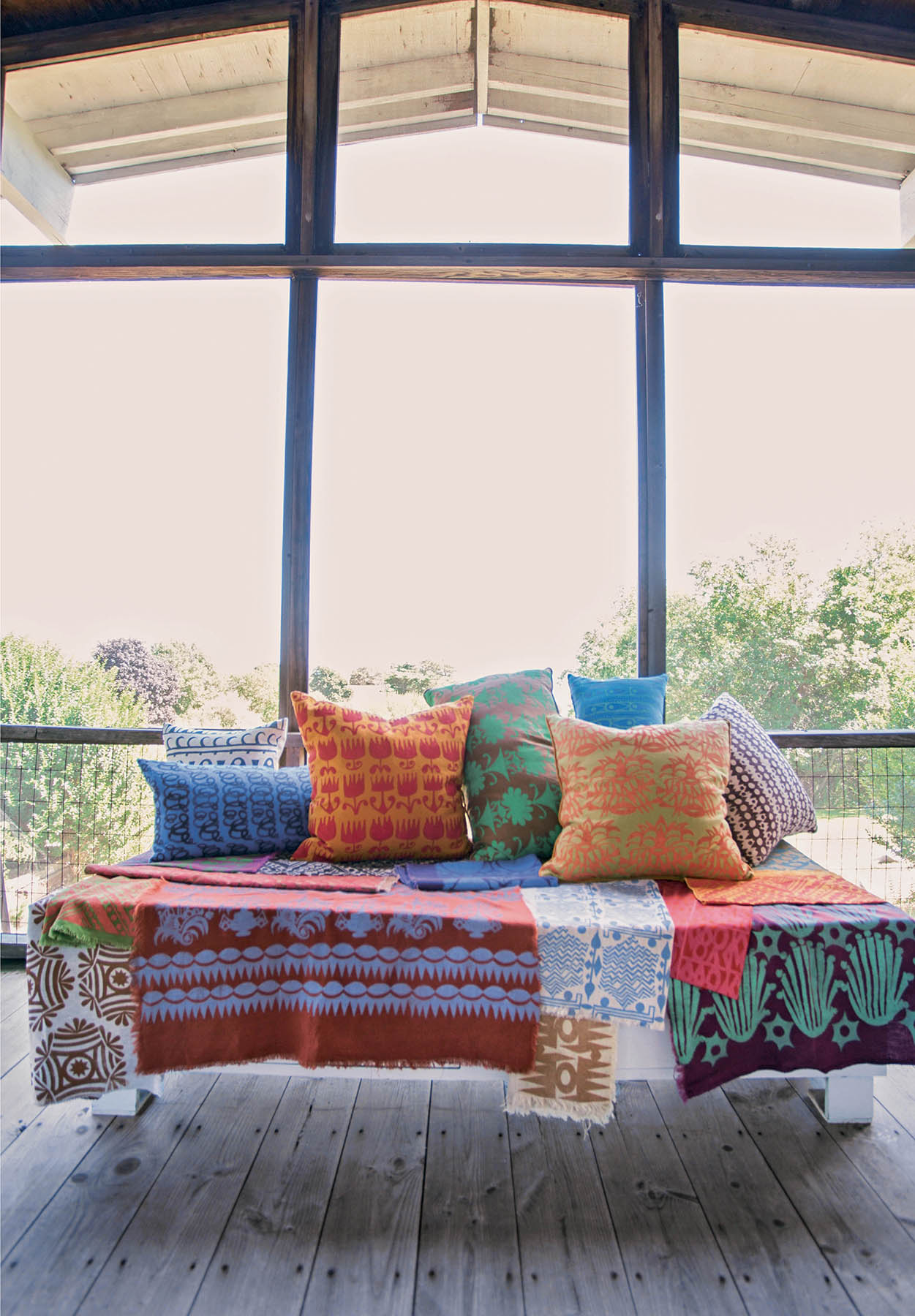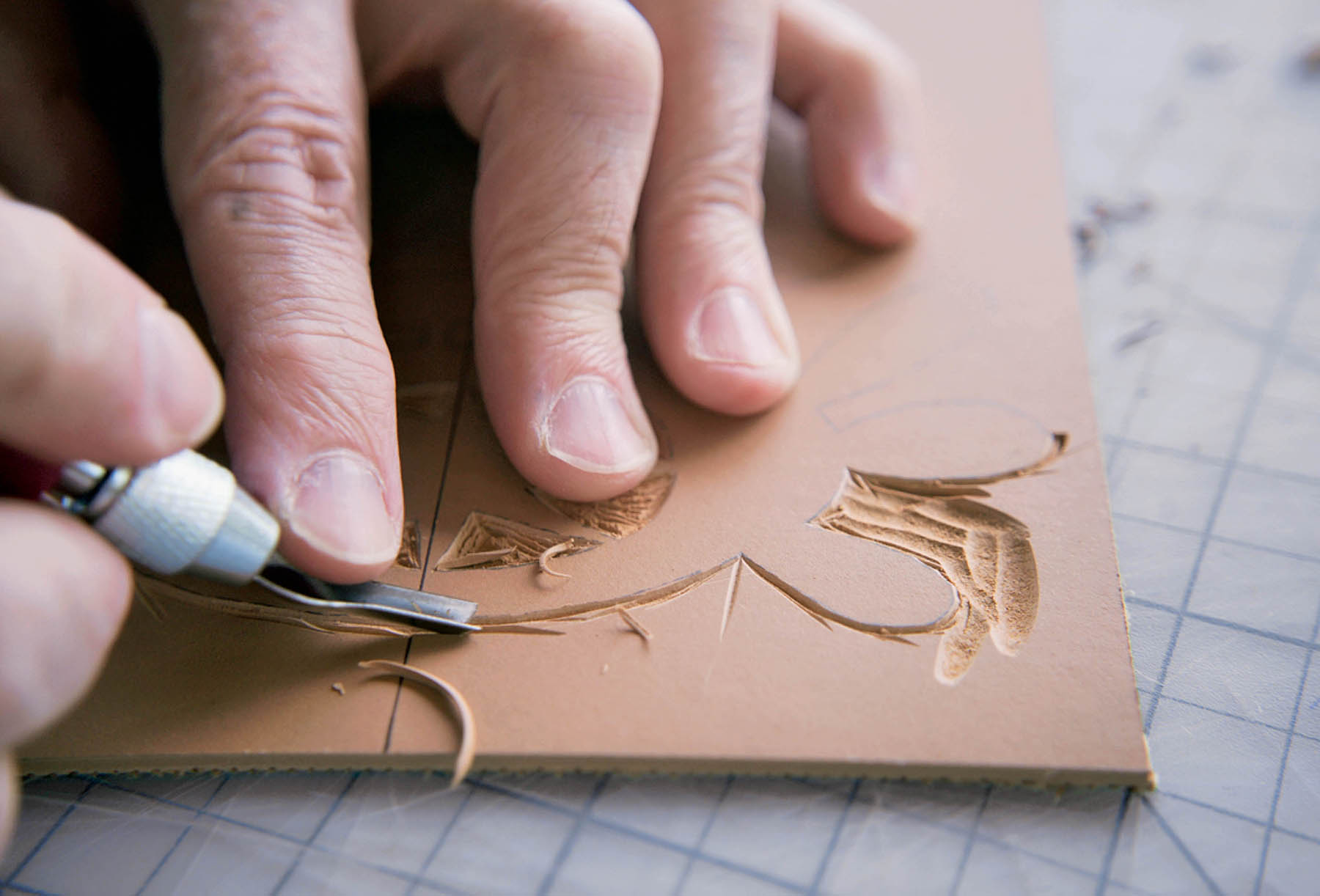Chip Dort
Living with a Big Brush

Chip at Clark Beach, located just down the hill from his house—a favorite place to take walks when he was a moody teenager in the 1960s, as well as today.
“The feeling I get when I make something I’m pleased with is like no other feeling I experience in my life. It’s a calm, quiet sort of jubilation. Other people can think what they want, but that doesn’t matter to me if I think it’s good and if I’m happy. Now I’m free to move on and make something else.”
From early childhood, Charles “Chip” Dort dreamed of becoming an artist. Most of the boys he grew up around in Ipswich, Massachusetts, in the late 1950s and early 1960s wanted to be astronauts or pilots, as he recalls. Chip was much more interested in creating cool stuff with his hands than in any kind of air travel. His mother recounts stories about how, as a toddler, he would pick through the trash in search of materials for art making. “I remember being thrilled because she had thrown away a cylindrical oatmeal container and thinking, ‘I can do something great with this,’ ” he says. He also reminisces about making scrolls with pretend Japanese writing, engineering a mazelike contraption for delivering water colored pink with cake-decorating crystals through a tunnel into a teapot, and carving heraldic crowns into carrots and potatoes for stamping. During elementary school, he painted a mural of a scene from the Revolutionary War on a wall in his classroom, and all the students in the school were paraded through to see his work. Chip was embarrassed by the attention but says, “That teacher was proactive in helping each one of us figure out what turned us on.”
Then there was Sister Vincent de Paul and her art classes at the new novitiate in town, off the main road and up a hill. Chip attended the sister’s Saturday-morning workshops for two years while in junior high and immersed himself in many types of media, including gouache, oil paints, pastels, and enameling. “I can still hear her voice,” Chip recounts. “She said, ‘Little brushes are for painting a mouse’s eyebrows. Get a big brush. Get in there.’ I loved going there. It was the only place or time of the week where I felt like what I thought and felt was important and there was someone to listen to me.”

A close-up of the block Chip uses to make his Indian Sun fabric. Chip limits the size of his blocks to about eight inches square to ensure that he can print with them comfortably and consistently. He glues flanges onto the backs of his blocks to make them easier to flip and print.
Chip was the eldest of four. His father was a high school biology teacher; his mother stayed at home until all the kids were school-aged and then went back to school herself and became an occupational therapist. Chip was the only family member interested in art and aesthetics. His father built the house they lived in, but not because of any creative urge. Chip explains: “We didn’t have money. If we were going to have a house, he would have to build it, so he taught himself how to do it.”
This is the same modest, ranch-style home overlooking Ipswich Bay where I meet Chip on a late-summer day and where he shows me the block-printed fabrics he began producing and selling under the brand name Drusus Tabor in 2015, forty-three years after he graduated from high school and left Ipswich for the first time. Chip headed to London to attend the Ravensbourne College of Art and Design, to become, he thought, a painter. Ravensbourne was the first of the five schools he studied at before earning his undergraduate degree in painting from Montserrat College of Art in 1992 and his master’s degree in painting and printmaking from Yale University in 1996. Being the eldest as well as single, Chip wasn’t all that surprised when, in 2015, it was determined that his elderly parents would need full-time care that he was the family member tasked with tending to them. He is, however, surprised that after so many years of artistic struggle, he has found his creative stride back in Ipswich, carving blocks for printing on his back porch and printing them in a makeshift studio down the road at his sister’s place.

An assortment of Chip’s pillows and fabrics arranged together on his back deck. Though the patterns Chip makes reflect a lifetime of studying art history, he says, “I don’t really care that someone understands that these patterns have a foot in ancient Rome or Egypt or China. If people can understand that there is a historical antecedent to the patterns, great, but that’s not first and foremost with me. I just get a kick out of them really loving it.”
On the wall in his parents’ living room is a large painting from Chip’s thesis show at Yale. The canvas is a remnant of 1950s upholstery cotton with a linear floral print he found in a fabric-store sale bin, on which he layered paint—depicting what looks like Japanese cherry blossoms at the top and gold baroque forms at the bottom. “I was playing with the juxtaposition of different decorative cultures,” Chip explains.
Decorative art has always been Chip’s passion, and he credits years of studying auction catalogs, from the time he was a teenager on, for much of his knowledge. “I find decorative art—the chairs people sat on, the utensils they used daily—to be a more immediate way of understanding the flavor of a time than the ‘important’ paintings and sculpture,” he says. But this lifelong passion has also made him feel like an outsider in the fine-art world. When one of his first college professors in London told him that his work wasn’t serious enough and he had “too much dash” to be a painter, he took that to mean that he didn’t have enough talent and dropped out. At Yale, he says, the faculty—despite admitting him into their MFA program—couldn’t comprehend what he was doing and criticized his work for being too decorative (which he interpreted as superficial), not, in their estimation, soul-searching, important, or relevant enough. “I kept casting about, searching for something I could sink my hooks into as a significant cultural, social message,” Chip remembers. Without that “imperative” message, he lacked the confidence to exhibit or try to sell his paintings and, in the meantime, found other ways to make a living. This included everything from managing a gourmet store to doing faux-finish paintwork, designing glassware, working with color expert Eve Ashcraft (whom he met while freelancing as a production assistant at Martha Stewart Living), and doing sales and research with renowned decorators and antiques dealers Amy Perlin, John Rosselli, and Bunny Williams.

Chip sketches, designs, and carves blocks in the house or, as shown here, on the back deck. He heads to a spare room at his sister’s place a few streets away to print them on linen, then ships the fabric to an expert upholsterer to make pillows.
When Chip moved out of his apartment and art studio in New York City in 2015 to return to Massachusetts, he knew he would have to give up painting for a while—he would have neither the time nor the space for it while caring for his parents—but he also knew that he had to find something else to make with his hands. (“Otherwise I would lose my mind,” he says.) So he turned to block printing, a medium he had dabbled in over the years, and nearly right away, shapes and patterns began spilling out of him as they never had before. It was as though all the previous decades of searching and struggle had led him to this moment when, with time and space so severely limited, everything he had taken in about the art of other eras and cultures was coming together. He was discovering his artistic voice—and a confidence that had, until then, eluded him.
Within the patterns he cuts into linoleum and then prints on linen, one can see hints of classical Greek vases, medieval shields, chinoiserie, African kuba cloth, and 1960s Marimekko prints, plus, of course, the idiosyncrasies produced by his own hands. His color combinations are bold, sometimes surprising, vibrating. At last, he is having fun—and feeling sure enough about his work to show it to the world. “The feeling I get when I make something I’m pleased with is like no other feeling I experience in my life,” says Chip. “It’s a calm, quiet sort of jubilation. Other people can think what they want, but that doesn’t matter to me if I think it’s good and if I’m happy. Now I’m free to move on and make something else.” The pillows he has made from his fabrics are for sale at Andrew Spindler Antiques & Design, a shop in the nearby town of Essex, where he also works one day a week, and on DrususTabor.com, where he shares his and the brand’s point of view: “We believe in the ineffable beauty and grace of handmade things. In today’s digitized, mechanized world, true luxury resides in those things made in real time, by a real person, using real materials.”

Chip pushes his lino cutting tool through the negative space of the design as precisely as possible in order to ensure that the positive space will print cleanly.
While there are those in the fine-art, and particularly the painting, community who may always see decorative art as lesser, Chip no longer feels that he needs to convince them otherwise or strive to satisfy them. “I was stubborn. I was sabotaging myself,” Chip understands now. He had set out to be a painter and felt as though straying from that course would be an admission of defeat, of unacceptable failure, so he kept trying to prove himself to a group of people whose ideas he didn’t actually agree with. But now he realizes that he was allowing their belief system to diffuse his own creative expression and, subsequently, holding himself back from full engagement with and enjoyment of his own life.
When we look at his pillows and fabrics arranged beautifully on his deck, near the table where he sits and carves his blocks, he says, “There they are in this big pile, all these ideas and colors and decisions, brought together. This makes me happy because it’s very lighthearted and positive.”
“It brings home the idea that you have found your voice,” I tell him, to which he adds, “Yup. I have. For me, there were times when it seemed like it was never going to happen, like I would drift for the rest of my life from one thing to the next trying to figure out what I am supposed to be doing. This is what I’m supposed to be doing.”
Chip expects that he will paint again, too, but it will be different from before. “It will be freer, more of an exercise in joy,” he says.
Chip will paint with a big brush as Sister Vincent de Paul, clad in her full dark habit and wimple, advised. “She was telling me to cut loose, not to be afraid; to try it, to get in there and muck about. Go for it.” And so he shall—on his own terms, in his own way.

A display of Chip’s pillows alongside a Frances Elkins chair at Andrew Spindler Antiques & Design in Essex.

Chip chose the brand name Drusus Tabor, shown here on his label, to convey an illusion of history and grandeur. Drusus is an ancient Roman name. Tabor was on a wall of names, carved over decades, in an old British boarding school (a photo of which he spotted in World of Interiors magazine). He tried out every name on the wall with “Drusus” before making a final decision.
printing day

As Chip block-prints his Gilded Star design at the long table he built for this purpose, he speaks about the allure of the medium: “There’s a natural progression that I find satisfying. You can count on it. You have to do this before you do that. There are no shortcuts. It’s due diligence.” And then there is the suspense and surprise. “You work very hard to carve this thing; you think it is going to print a certain way. Then you get to print it, but you don’t see what’s happening until you lift the block away. And that’s when you find out if you’ve achieved what you have been hoping for. Is it even better than you thought it would be?”







